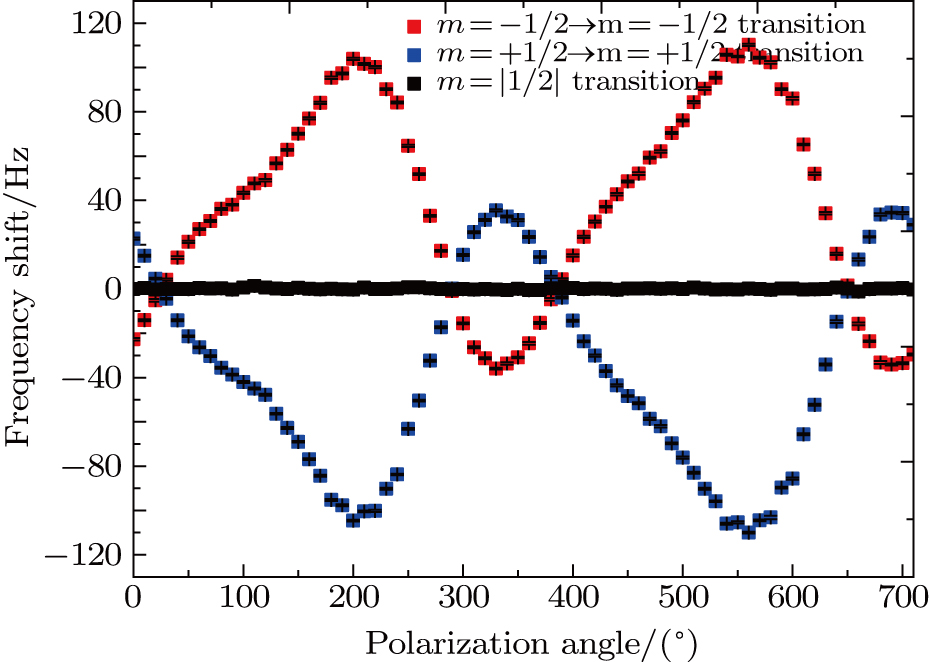† Corresponding author. E-mail:
Project supported by the National Natural Science Foundation of China (Grant Nos. 91336211, 11634013, 11622434, 11474318, and 11504094) and the Chinese Academy of Sciences (Grant No. XDB21030000).
Ac-Stark shift of atom levels is caused by an ac-electromagnetic field. As an electromagnetic wave, laser light does induce ac-Stark shift. It is proved experimentally that if the light is linearly polarized, the dynamic polarizability changes with polarization direction. The polarization direction of the linearly-polarized laser is tuned by 720°, and the ac-Stark shifts of the 4S1/2,m = ±1/2 → 3D5/2, m = ±1/2 clock transitions in 40Ca+ are measured in steps of 10°. The frequency shifts change with laser polarization in a periodical manner and have values opposite to each other.
Polarizability is an intrinsic property of atoms, which determines how the atoms respond to an external field dynamically. Studying the polarizability of atoms is indeed helpul in many fields.[1–17] Research on the dynamic polarizability of atoms or ions will provide knowledge of the magic wavelength[1–8] corresponding to relevant transitions. Black-body shift of the clock transition frequency can be evaluated through its static polarizability.[9–13] The dynamic polarizability is also helpful in constructing the long-range-potential which is crucial in Bose–Einstein condensation,[14] cold and ultracold collisions,[16] and ultracold photoassociation spectroscopy.[17] The laser used in transition frequency measurement will introduce ac-Stark shift, which is unavoidable, by changing the dynamic polarizability.[9–13]
For a given state of an atom or ion, denoted as d, with angular momentum and angular momentum projections denoted as j and m, an electromagnetic field brings a shift in energy as given as[1,4,6–8]
 |
 |



We have measured the frequency shifts of the 3D5/2,m = |1/2| → 4S1/2,m = |1/2| transitions at the magic wavelength[7,8,17,18] of this transition couple in 40Ca+. The average of these two shifts stays at the constant value of zero but each single shift changes periodically with the angle between polarization direction of the linearly-polarized laser and the z axis. This means that the magic wavelength is “magic” to just the average frequency shift of those two transitions and not “magic” to each single one. The frequency shifts of these two transitions can reach the same value of zero at a certain polarized angle of the laser light. In magic wavelength measurement, if we set the laser's polarized angle at this value, it will take us less time to reach the same precision than in Ref. [18].
It is not specific for magic wavelength that the frequency shift changes with the polarized angle of the light periodically. If we change the wavelength of the laser light, the average frequency shift will also stay constant but not at zero and each single shift will change periodically in the constant center. In the transition frequency measurement, the ac-Stark shift is unavoidable for the use of several laser beams. Research on the relationship between frequency shift and laser polarization direction will improve the precision of the transition frequency measurement.
A partial level scheme of 40Ca+ is depicted in Fig.
The experimental setup is briefly sketched in Fig.
A single 40Ca+ ion is trapped in a miniature Paul trap and Doppler cooled with the 397-nm cooling laser and the 866-nm repumping laser. The excess micromotion of the ion is reduced by optimizing the voltages applied to the compensating electrodes. The ion temperature is minimized to a few mK and the ion can be trapped for several days. The pulse sequence used in our experiment is similar to the one used in our clock frequency measurement.[9,22,23] In the cooling process, the 854-nm laser is switched on for 1 ms as shown in Fig.
Under the effect of magic wavelength light, the average of frequency shifts of 4S1/2,m = −1/2 → 3D5/2,m = −1/2 and 4S1/2,m = −1/2 → 3D5/2,m = + 1/2 transition stay at the constant value of zero as shown in Fig.
We measure the frequency shifts of a couple of clock transitions corresponding to 3D5/2,m = ± 1/2 with different laser polarizations directions at the magic wavelength of the 4S1/2,m = |1/2| → 3D5/2,m = |1/2| transition couple. Frequency shifts change with laser polarization periodically and have opposite values constantly. Rotating the polarizer to a certain angle precisely which is about 12.5° or 145° here, both of the shifts go to zero. If the polarizer is fixed at the angles, “four point locking scheme”[25,26] can be replaced with “two point locking scheme” in magic wavelength measurement, which will take less time to achieve the same accuracy.
In the transition frequency measurement, the lasers used in probing will cause ac-Stark shifts. The average shift of a transition coupled with the same values of angular momentum j and absolute value of angular momentum projection m is constant but not zero. Each single shift corresponding to either of the transition couples will change in a periodical manner with laser polarization direction in the constant center. If the relationship between shift and laser direction is measured specifically, then a certain direction can be chosen to lead to the smallest ac-Stark shift during single transition frequency measurement.
| [1] | |
| [2] | |
| [3] | |
| [4] | |
| [5] | |
| [6] | |
| [7] | |
| [8] | |
| [9] | |
| [10] | |
| [11] | |
| [12] | |
| [13] | |
| [14] | |
| [15] | |
| [16] | |
| [17] | |
| [18] | |
| [19] | |
| [20] | |
| [21] | |
| [22] | |
| [23] | |
| [24] | |
| [25] | |
| [26] |





